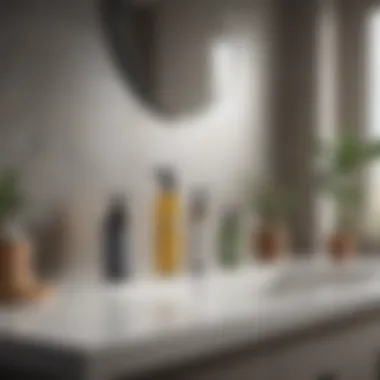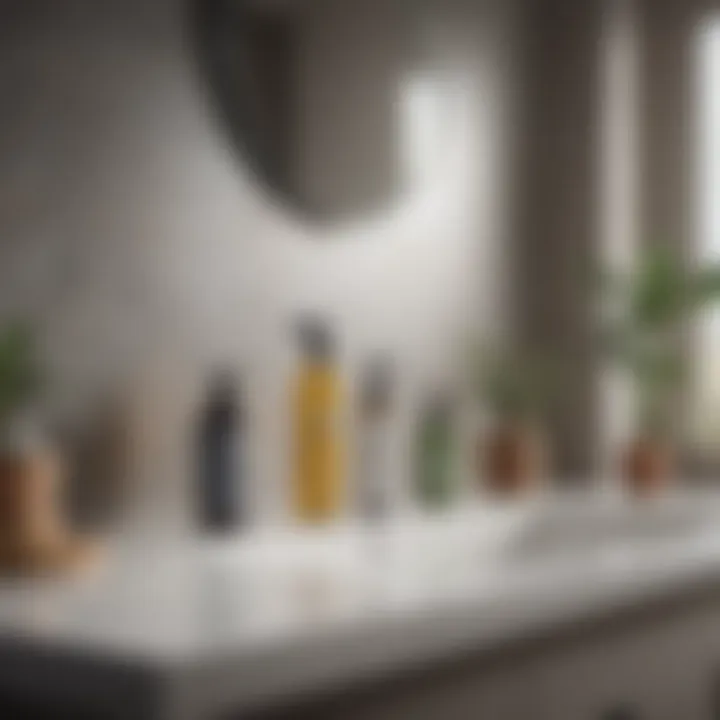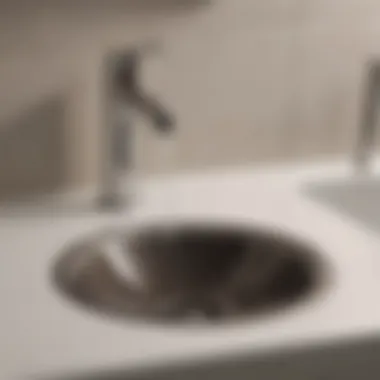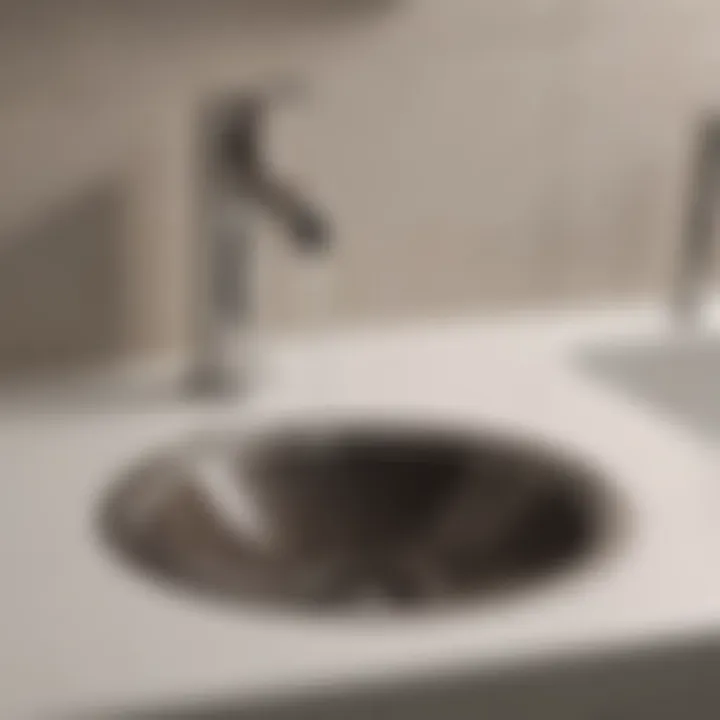Comprehensive Guide to Cleaning Your Bathroom Sink Drain


Intro
Cleaning your bathroom sink drain can be often overlooked, yet it is essential to maintain not just hygiene but also functionality. An unclogged and fresh drain contributes to the overall health of your bathroom plumbing system, preventing costly repairs down the line. In this guide, we will thoroughly explore effective techniques for cleaning your sink drain, analyzing the importance of regular maintenance, suitable cleaning agents, and step-by-step methods for various cleaning techniques.
Regular maintenance is key to preventing the accumulation of dirt, hair, and soap deposits, which can lead to blockages and unpleasant odors. By understanding the most effective cleaning approaches, you can preserve your sink's functionality while enhancing the aesthetic appeal of your bathroom.
Exquisite Architectural Designs
While cleaning might not seem to directly relate to architectural design, a well-maintained bathroom enhances the overall design experience in a home. A clean bathroom with a functional sink drain contributes significantly to the comfort and usability of the space, which is a key principle in exquisite architectural designs.
Unique Home Features
Every bathroom is unique in its design and functionality. The materials selected for sinks, faucets, and drains can vary significantly. Some homeowners opt for porcelain, while others prefer stainless steel or even glass. Each material requires specific cleaning approaches to maintain its integrity and appearance. Regular cleaning helps ensure those distinct features are not only visually appealing but also fully functional.
Historical Significance
The evolution of bathroom design reflects broader trends in society and technology. The materials and designs used can often signify a period in history. For instance, the modernist movement emphasized minimalism, which reflects in current designs with simple geometric shapes. Understanding these historical contexts can improve the appreciation for maintaining these areas of the home and the necessary upkeep involved.
Effective Cleaning Techniques
To ensure optimal drain performance, one must familiarize oneself with effective cleaning techniques. This includes identifying suitable cleaning agents and executing specific methods based on the nature of the blockage or build-up.
Common cleaning agents include:
- Baking soda
- White vinegar
- Dish soap
- Commercial drain cleaners
The selection of agents often depends on personal preference and levels of blockage present in the sink.
Step-by-Step Instructions
- Gather necessary tools: Before starting, ensure you have everything you need, such as a plunger, a drain snake, or a bottle brush.
- Clear debris: Remove any visible debris from the drain. Hair and soap residue are common culprits.
- Use baking soda and vinegar: Pour a half-cup of baking soda into the drain, followed by a half-cup of white vinegar. Wait for about 15 minutes before rinsing with hot water. This method works well for minor clogs.
- Apply the plunger: If the blockage persists, cover the overflow outlet with a wet cloth and use a plunger vigorously.
- Drain snake: For deeper clogs, insert a drain snake and twist it to break up the obstruction.
Tip: Always follow up with hot water to flush out any remaining residue or loosened blockage.
Preventive Measures
To avoid the need for frequent clean-ups, consider implementing preventive measures. Use drain screens to catch hair and larger particles before they enter the drain. Regularly cleaning with baking soda and vinegar can be an effective monthly maintenance practice.
Environmentally Friendly Practices
As eco-consciousness grows, many cleaning methods can help maintain your sink drain without harming the environment. Utilizing natural ingredients like baking soda and vinegar not only avoids harsh chemicals but is also effective for most maintenance tasks.
Preamble to Bathroom Sink Drain Maintenance
Maintaining the bathroom sink drain is important for many reasons. A properly functioning drain enhances the comfort of the bathroom experience. Over time, dirt, soap residues, and other particles can accumulate in the drain. This results in slow drainage and unpleasant odors. Taking steps to maintain the drain can prevent these issues and prolong the life of plumbing components.
Regular cleaning of the bathroom sink drain serves multiple functions. It helps to avoid major clogs that require extensive intervention. Additionally, clean drains contribute to better hygiene. Regular maintenance reduces the likelihood of pests or mold growth. Keeping drains clear and clean is crucial for overall bathroom health.
In summary, understanding the significance of cleaning your bathroom sink drain can save time and money in the long run. It encourages a proactive approach rather than a reactive one when dealing with drain issues.
Importance of Regular Cleaning
Regular cleaning of bathroom sink drains cannot be overstated. It leads to a smoother flow of water and minimizes blockages. Establishing a routine cleaning schedule can keep the drain free from buildup. This avoids the need for harsh chemical treatments that may damage the plumbing over time. Cleaning your drain regularly can make a significant difference in its performance and longevity.
Moreover, regular maintenance contributes to a healthier bathroom environment. Stagnant water and the buildup of organic matter can attract pests. Keeping the drain clean ensures peace of mind regarding hygiene.
Consequences of Neglect
Neglecting to maintain bathroom sink drains can lead to several negative consequences. Over time, accumulated debris can lead to more severe blockages. When water cannot flow freely, it often leads to overflow. This can damage cabinets or flooring, leading to costly repairs.
Additionally, clogged drains can produce foul smells that permeate the space. These odors can be embarrassing and detract from the overall bathroom experience. If left untreated, neglecting your drain can also require professional intervention. Unwittingly ignoring these issues can increase expenses in the long run. Regular attention can prevent these scenarios and ensure a smooth and pleasant experience in the bathroom.
Understanding the Drain System
Understanding the drain system in your bathroom sink is pivotal, especially when contemplating cleaning or maintenance. The drain system is not merely a conduit for water disposal; it comprises various integral components that work in unison to ensure proper drainage. Knowing how these components function aids in identifying issues and executing effective cleaning methods. A well-maintained drain prevents blockages, thereby preserving the integrity and functionality of your sink. Furthermore, awareness of the system helps you make informed decisions about which cleaning agents to use, which are safe for both the plumbing and the environment.


Components of a Bathroom Sink Drain
Every bathroom sink has several critical components that make up its drain system:
- Basin: This is the visible part where you wash your hands and face.
- Overflow Hole: Found near the rim, it prevents water from spilling over if the sink fills too much.
- Drain Stopper: Used to block the water from flowing down the drain when you want to fill the sink.
- Drain Pipe: Carries wastewater away from the sink, typically sloping downwards.
- P-Trap: A curved section of pipe that holds a small amount of water to prevent sewer gases from entering your home.
- Vent Pipe: Facilitates air flow which helps water to drain smoothly by preventing vacuum formation.
Recognizing these components lets you understand where potential problems may arise. For instance, a clogged P-trap can inhibit drainage, leading to water buildup.
Common Problems Faced
Common issues associated with bathroom sink drains include:
- Clogging: Frequently caused by hair, soap residue, and toothpaste, this can disrupt the normal flow of water and lead to unpleasant odors.
- Slow Draining: This may indicate a partial blockage somewhere in the drain system, signaling a need for immediate attention.
- Bad Odors: Unpleasant smells may result from decomposition of debris in the drain or from a dry P-trap.
- Leaking: Any visible dripping or water pooling can mean there's a problem with the seals or connections in the drainage system.
Understanding these common problems empowers homeowners to take proactive measures. Early identification and resolution can prevent more serious plumbing issues that might require professional intervention.
Identifying Suitable Cleaning Agents
Choosing the right cleaning agents is crucial in maintaining an effectively working bathroom sink drain. The wrong choice can lead to insufficient cleaning, potential damage to your plumbing, or even health risks due to harmful chemicals. Thus, being mindful about your selections is vital.
Firstly, knowing what type of clog you are dealing with helps determine the right cleaning agents. Some blockages may respond better to natural solutions, while others might need stronger chemical cleaners. The goal is to ensure that the cleaning method aligns with the particular problem you face, thereby maximizing effectiveness while reducing risks.
Additionally, considering the impact on the environment is essential. Eco-friendly options have become increasingly popular, not only for their effectiveness but also for their reduced environmental footprint. Using the right cleaning agents can also help protect your plumbing system, prolonging its lifespan and maintaining the overall health of your home’s plumbing network.
"A well-maintained drain system contributes significantly to a hygienic and pleasant living space."
Chemical Cleaners
Chemical cleaners are often quick and effective, making them a popular choice for drain cleaning. These products usually contain robust ingredients designed to dissolve organic matter, fats, and soap residues. Brands like Drano and Liquid-Plumr are examples of widely recognized chemical drain cleaners.
When using chemical cleaners, it is vital to follow the instructions carefully. Here are some points to keep in mind:
- Safety: Always use gloves and goggles when handling chemical cleaners. They can cause burns or irritation.
- Ventilation: Ensure proper airflow in your bathroom while using these chemicals to avoid inhaling potentially harmful fumes.
- Compatibility: Not all chemical cleaners are suitable for every plumbing system. Older pipes or those made from specific materials may react adversely to certain chemicals.
While chemical cleaners can offer quick relief, they should not replace regular maintenance and preventive cleaning.
Natural Alternatives
Natural cleaning agents offer an eco-friendly option that can be just as effective as their chemical counterparts. These alternatives typically consist of readily available household items like baking soda, vinegar, and lemon juice. The use of such ingredients aligns with a trend towards sustainability in household cleaning.
Using baking soda combined with vinegar is especially popular due to its ability to create a fizzy reaction. This reaction can help dislodge minor clogs and eliminate odors. Similarly, lemon juice not only offers a pleasant scent, but its acidity can aid in breaking down organic debris.
Here are benefits of utilizing natural alternatives:
- Safety: They pose fewer risks to your health and are generally safe for your plumbing.
- Environmental: Natural cleaners minimize chemical runoff, which can negatively affect local waterways.
- Cost-Effectiveness: Household items tend to be cheaper than commercial cleaning products and are often more readily available.
DIY Cleaning Techniques
Cleaning your bathroom sink drain utilizing do-it-yourself methods can be an effective approach. Many homeowners may overlook these techniques, but they offer numerous benefits. First, DIY cleaning methods are often cost-effective. You likely have common household items readily available, such as baking soda, vinegar, and dish soap. These substances can be powerful allies in tackling stubborn clogs and maintaining flow.
Additionally, there is a satisfaction that comes with fixing problems yourself. Engaging in DIY cleaning fosters a sense of accomplishment, knowing you are directly responsible for improving your space. Importantly, DIY methods are often free from harmful chemicals, promoting a healthier environment in your home. Understanding these aspects can empower you to maintain your sink and prevent issues before they escalate.
Using Baking Soda and Vinegar
Using baking soda and vinegar is a tried-and-true method for cleaning bathroom sink drains. This method works through a simple chemical reaction. When baking soda and vinegar are combined, they create fizzing action that can help dislodge debris trapped within the drain. To employ this technique, start by measuring half a cup of baking soda and pouring it down the drain. Follow this with half a cup of vinegar. You should hear a bubbling sound as the two ingredients react.
After letting the mixture sit for about 30 minutes, flush the drain with hot water. This process can generally clear minor blockages and help reduce odors.
Employing Boiling Water
Employing boiling water for drain cleaning is one of the simplest DIY methods. Hot water can dissolve soap scum and grease that accumulate in the pipes over time. To use this technique, simply boil a kettle of water. Once it reaches a rolling boil, pour it down the drain slowly, in stages. Allow it to work for a minute before adding more. This method is particularly effective for cleaning single-use clogs. It's a practical solution that requires little preparation and delivers results quickly.
Utilizing Dish Soap
Utilizing dish soap is another straightforward method to clean your bathroom sink drain. Dish soap is designed to break down grease and food particles. To do this, squirt a generous amount of dish soap directly into the drain. Follow with hot water, as with the boiling water method. The combination of soap and hot water can effectively eliminate build-up. This method is not only effective for clearing clogs but can also be used regularly as a preventive measure.
Regular maintenance of your sink drain is crucial in preventing blockages and ensuring longevity.


By engaging these DIY cleaning techniques, you can keep your bathroom sink drain functioning smoothly. This not only saves you time and money but also enhances the overall hygiene and efficiency of your bathroom.
Step-by-Step Cleaning Process
The step-by-step cleaning process is not just about getting rid of clogs or collecting dirt; it is essential for ensuring the long-term functioning of your bathroom sink drain. This systematic approach offers clarity and efficiency, helping homeowners maintain an optimal drainage system. By following a structured method, one can avoid over-complicating the task, simplifying the cleaning process significantly. This helps in identifying problems early and addressing them before they escalate into larger issues, potentially saving time and costly repairs.
Incorporating regular cleaning into your routine can lead to benefits such as enhanced water flow and a cleaner sink environment. It also provides an opportunity to check for any signs of wear and tear, ensuring your plumbing remains in good condition. As we discuss the specific steps involved, each section will emphasize the importance of using appropriate tools and techniques designed for effective drain cleaning.
Preparation and Tools Required
Before embarking on the cleaning process, proper preparation is key. Gather all necessary tools to streamline the process and reduce downtime. Here are some tools to have ready:
- A plumber's snake or drain auger for deeper clogs.
- Gloves to keep your hands clean while handling dirty tools and materials.
- A bucket to catch any water and debris.
- Vinegar and baking soda for natural cleaning agents.
- A screwdriver to remove any trap components, if required.
- A dish soap to help cut through grease and buildup.
Make sure to also remove any items stored under the sink. This creates an accessible working area, allowing for a thorough inspection of the drain system, which is beneficial before actual cleaning begins.
Cleaning the Drain Trap
The drain trap is a crucial component of your bathroom sink's plumbing system, designed to prevent sewer gases from entering your home. Cleaning this part requires a bit of disassembly but is essential for maintaining proper drainage. Follow these steps to clean it:
- Turn off the water supply to avoid any disruptions.
- Place a bucket under the sink to catch any waste.
- Using a screwdriver, detach the trap from the plumbing. This is usually a straightforward process; be mindful of any washers or seals you may need to replace later.
- Clean the trap with hot water and dish soap. Use a scrub brush if necessary to remove any stuck debris.
- Rinse thoroughly before reattaching it to the sink.
This process removes both visible and hidden blockages that can lead to more significant issues if left unchecked.
Flushing the Drain
After cleaning the drain trap, the next step is to flush the drain. This is important for clearing away any remaining debris and for ensuring a clear flow of water.
- Begin by pouring hot water down the drain. The heat helps to dislodge grease and small particles stuck in the pipes.
- Follow with a mixture of baking soda and vinegar. The reaction between these two elements can help break down any stubborn buildup. Allow it to sit for about 30 minutes to maximize effectiveness.
- Finally, flush the drain again with hot water to clear out the mixture and any lingering debris.
The flushing step ensures that small clogs are cleared and that your drain operates at peak efficiency. Engaging in this process regularly can lead to fewer instances of severe clogging, making drain maintenance seamless.
Addressing Specific Clogs
Addressing specific clogs in your bathroom sink drain is a critical aspect of overall drain maintenance. This segment covers some prevalent issues, and understanding them can save you time, effort, and costly plumbing repairs. Knowing how to effectively tackle each type of clog not only keeps your drain clean but also extends its lifespan. Proactive measures can lead to fewer unexpected problems in the future, helping you maintain a well-functioning bathroom.
Hair Clogs
Hair clogs are one of the most common issues faced in bathroom sinks. Hair can accumulate in the drain over time, forming a dense blockage that prevents water from flowing freely. This issue is not exclusive to long hair; even short hair can contribute to the problem. Regular cleaning can help mitigate this issue before it becomes severe.
To remove hair clogs, start by using a pair of tweezers or a hook tool specifically designed for this purpose. Simply insert it into the drain to pull out any visible hair. For stubborn clogs, a mixture of baking soda and vinegar can be very effective. Pour the baking soda followed by the vinegar down the drain. Wait for 30 minutes, then flush it with hot water. This method can dissolve hair and other residues.
Soap Build-up
Soap build-up occurs when the soap residue combines with minerals from the water. This residue creates a sticky layer inside the drain, leading to restricted water flow. Over time, this can lead to significant clogs. Soap build-up is more evident in homes with hard water, as the minerals promote the accumulation of soap-related residues.
To address soap build-up, using a mixture of equal parts vinegar and hot water can provide a solution. This combination helps break down the residues. Pour this mixture down the drain and let it sit for about 15 minutes. Afterward, flush the drain with hot water. Consider bleaching agents as well, but they should be used sparingly and with caution.
Food Particles
Although food particles are typically associated with kitchen sinks, bathroom sinks are not immune to this issue. Small food residue can accumulate, especially if you wash your hands after eating. Over time, these residual particles can create clogs.
To remedy this, ensure you rinse your sink often and do not allow food particles to sit. If clogs do develop, use a mixture of baking soda and hot water, similar to treating hair clogs. An alternative method involves utilizing a drain snake to physically remove larger particles stuck deeper in the drain.
Proper drain cleaning techniques can reduce the frequency of clogs and maintain the aesthetics of your bathroom while ensuring functional efficiency.
Preventive Measures for Drain Maintenance
Maintaining a bathroom sink drain is not solely about emergencies or significant clogs; it also involves preventive steps that can save you from future grievances and repair costs. This section delves into two essential preventive measures: having a regular cleaning schedule and utilizing drain screens. Both approaches help maintain the drain's efficacy and prolong its life.
Regular Cleaning Schedule
Establishing a consistent cleaning routine for your bathroom sink drain is crucial. Cleaning does not have to be overly meticulous or demanding. Small, regular maintenance tasks can often preempt substantial problems. A bi-weekly or monthly schedule is usually adequate for most households.
Here are some benefits of a regular cleaning schedule:


- Prevention of Build-up: Over time, soap scum, hair, and other debris can accumulate in the drain. Regular cleaning helps to remove these materials before they cause clogs.
- Odor Control: A neglected drain tends to emit unpleasant smells. Routine cleaning can eliminate the organic materials that cause odors.
- Increased Efficiency: Regularly maintained drains perform better. This means a faster flow of water and fewer interruptions, maintaining the sink's usability.
- Cost-Effectiveness: Preventive cleaning can reduce the need for professional services, saving money in the long run.
Implementing a schedule may involve simple tasks such as pouring boiling water down the drain or using a baking soda and vinegar solution. The key is to make it a habit, integrating it easily into your overall cleaning routine.
Installing Drain Screens
Drain screens are an often overlooked yet vital preventive measure for maintaining a bathroom sink drain. These devices act as barriers, catching debris before it can enter and clog the drain. Their importance cannot be overstated.
Consider the following points about drain screens:
- Effective Debris Collection: Drain screens prevent hair, soap, and other materials from being washed down the drain, which can significantly reduce the risk of clogs.
- Variety of Options: They come in various sizes and styles, easily fitting most sinks. Options range from simple mesh to more decorative models, ensuring that functionality does not interfere with aesthetics.
- Ease of Use: Most drain screens are easy to install and clean. They can simply be removed and rinsed off under running water, requiring minimal effort.
- Long-Term Savings: While there is an initial cost involved in purchasing drain screens, the prevention of clogs can save significant money spent on plumbing repairs.
"An ounce of prevention is worth a pound of cure". The relevance of this saying resonates profoundly within the context of drain maintenance. By undertaking these simple, preventive measures, the longevity and functionality of your bathroom sink drain can be preserved.
Environmental Considerations
Cleaning the bathroom sink drain effectively requires an awareness of the environmental footprint associated with various methods. This section will cover the significance of eco-friendly practices, the consequences of chemical cleaners, and how minor changes can make a substantial difference.
Eco-Friendly Cleaning Tips
Using environmentally friendly products to clean your drain offers numerous benefits. Here are some simple yet effective tips:
- Baking Soda and Vinegar: This combination acts as a natural cleaner. Pouring baking soda followed by vinegar into the drain can help to break down grime and prevent foul odors without harming aquatic life.
- Lemon Juice: Apart from its pleasant scent, lemon juice has natural antibacterial properties. Pouring lemon juice down the drain not only cleans but also freshens it.
- Salt: Salt is abrasive and can help to scrub away build-up in the pipes. Mix it with boiling water for even better results.
These options mitigate the use of harsh chemicals, promoting healthier indoor and outdoor environments.
Impact of Chemical Cleaners
Chemical cleaners, while effective in short-term drain maintenance, pose significant risks. Many contain caustic substances that can corrode pipes over time. These products contribute to water pollution and can adversely affect marine ecosystems when rinsed away.
- Toxic Ingredients: Some chemical cleaners include ingredients such as sodium hydroxide and hydrochloric acid, which are hazardous to both human health and the environment.
- Ineffective Long-Term Solutions: While chemical cleaners may clear a clog temporarily, they do not address underlying issues that cause recurring problems. In some cases, they can exacerbate the build-up of materials in the pipes.
These factors suggest that relying on chemical cleaners could lead to greater costs in repairs and environmental damage.
In summary, adopting eco-friendly cleaning methods not only preserves the integrity of plumbing systems but also safeguards the environment. Making informed choices contributes to better health for both people and ecosystems. In doing so, homeowners become stewards of their surroundings, emphasizing a holistic approach to home maintenance.
When to Seek Professional Help
Determining when to call a professional for your bathroom sink drain issues is crucial. Not all drain problems can be easily solved with DIY methods. A professional can diagnose issues beyond simple clogs, ensuring long-term solutions and preventing further complications.
Signs of Severe Clogging
Severe clogs often manifest through noticeable warning signs. Recognizing these signs early can save you time and unnecessary headaches later. Look out for the following:
- Regular Backups: If water frequently backs up into the sink, this indicates a deeper issue within the drain system.
- Slow Drainage: When water drains at a slower rate consistently, it suggests build-up or blockage that typical cleaning cannot resolve.
- Unpleasant Odors: Foul smells coming from the drain may indicate decaying organic matter trapped inside, which poses health risks.
- Gurgling Sounds: Hearing gurgling noises when you use other fixtures, like the toilet, can indicate air trapped in the plumbing, hinting at more serious blockage.
If you observe any of these signs, consulting a professional is advisable. They have specialized tools and expertise that can address the problem effectively.
Identifying Structural Problems
In some cases, sink drain issues may stem from structural problems within your plumbing system. Understanding these can be vital for maintaining your bathroom’s functionality. Here are some structural concerns to be aware of:
- Pipe Damage: Cracks, leaks, or corrosion in pipes can lead to significant drainage problems. A visual inspection by a professional can reveal hidden damage.
- Misalignment: Pipes that are not correctly aligned can cause improper drainage. Over time, this can create persistent clogs and leaks.
- Vent Pipe Issues: Vent pipes balance air pressure within the plumbing system. Problems with these can lead to drainage issues and must be addressed by a qualified plumber.
End
In wrapping up our detailed exploration of bathroom sink drain maintenance, it’s important to recognize the significance of consistent cleaning and care. This article has illustrated the multifaceted approach required for proper drain upkeep, emphasizing the necessity of recognizing the components of a drain system and the common issues that can arise if left unchecked.
Summarizing Key Points
To encapsulate the main takeaways:
- Regular Maintenance: One of the key points outlined is that maintaining a clean drain is essential to prevent severe issues down the line. Establishing a consistent cleaning schedule contributes greatly to functionality.
- Identifying Clogs: We have examined various types of clogs, including hair, soap residue, and food particles, emphasizing the unique approaches needed for each.
- DIY Techniques: Practical cleaning methods have been discussed, which can significantly reduce dependence on commercial products while being effective.
- Preventive Measures: Strategies like installing drain screens contribute to ongoing maintenance, limiting the likelihood of clogs.
- Environmental Concerns: Attention to eco-friendly practices while cleaning maintains the balance of health for both the plumbing system and broader environment.
Final Thoughts on Drain Maintenance
As a final note, the responsibility of drain maintenance does not solely rest on immediate releases of clogs. It is a continuous process. Regular attention and employing routine checks will help in ensuring that your bathroom retains its usability and aesthetic integrity.
By prioritizing a clean and efficiently functioning sink drain, homeowners not only safeguard their plumbing but also enhance the overall appeal of their bathrooms. This attention to detail distinctly reflects a care for home environment, making a strong impression on anyone who may enter your space.
"A small investment of time in maintaining your bathroom sink can lead to significant gains in functionality and aesthetics."
Ultimately, cleanliness and functionality will coexist harmoniously, elevating both your living conditions and mindset towards home care.















